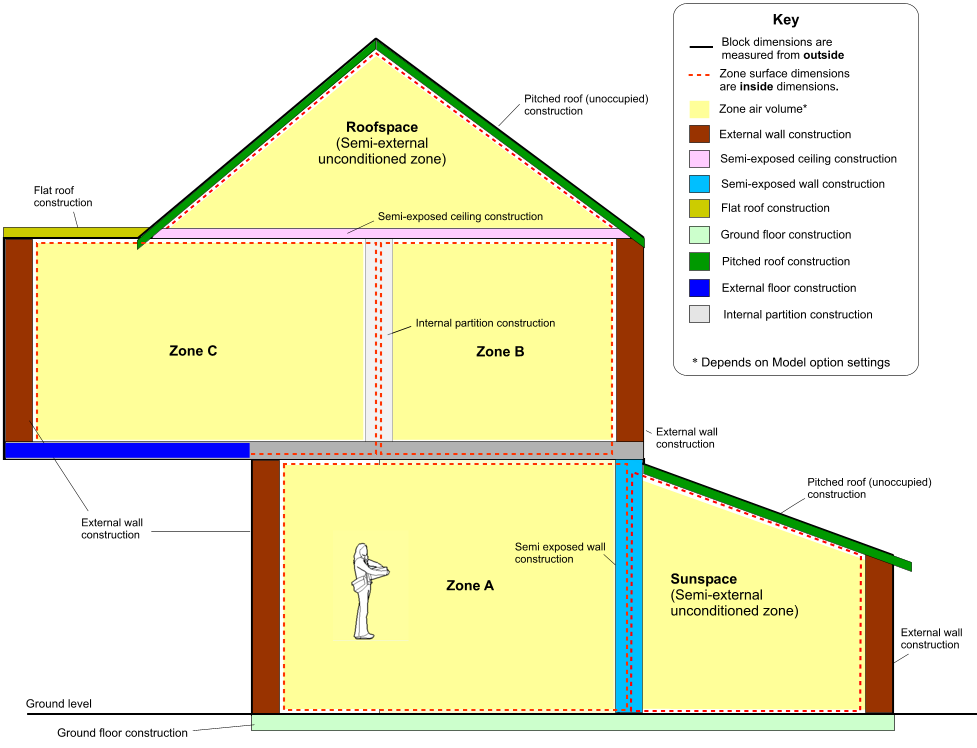
Construction tab in model data under Construction header
When the Floor/slab/ceiling representation model option is set to Combined wall, floor and roof constructions are all defined using simple constructions as shown in the diagram below.
The diagram shows:
The schematic below shows the locations of the surface types and the constructions that will be applied to them.

The external wall construction defines the construction of walls adjacent to outside. The definition of walls is given by the roof-wall transition angle model option. In cold climates this construction will generally include an insulating layer.
Flat roof constructions apply to external horizontal surfaces. The construction used to represent the flat roof should include any slabs, insulation and suspended ceiling layers. If there are no flat roof surfaces, just ignore this data.
The Pitched roof (occupied) construction applies to external sloped surfaces when they appear in occupied zones. In cold climates this construction will generally include an insulating layer. If there are no pitched roof surfaces, just ignore this data.
The definition of 'pitched roof' is given by the roof-wall transition angle model option.
The Pitched roof (unoccupied) construction applies to external sloped surfaces when they appear in semi-exterior unconditioned zones. This construction will generally not include any insulation layers. If there are no pitched roof surfaces, just ignore this data.
The definition of 'pitched roof' is given by the roof-wall transition angle model option.
The internal partition construction defines the construction of internal partitions (walls used to divide blocks into zones) and inter-block partitions (internal walls shared with other blocks). Internal partitions are used where both zones are occupied. When one of the zones is occupied and the other is not the Semi-exposed walls construction data is used (below). If there are no partitions just ignore this data.
The construction for the partition should represent all the layers in the actual internal wall. There is only one element representing the partition between the zones and all it's layers should be defined in the same construction.
Note that changes in model data settings at the surface level are reflected as equivalent changes in data for the partition on the other side.
The semi-exposed wall construction applies to walls between fully occupied zones and Semi-exterior unconditioned zones. They will normally include some insulation. DesignBuilder determines which of the zones is relatively 'outside' and uses this information to correctly order the material layers in the wall. The material layer defined in the construction as being 'outermost' (first-in list) will be the one adjacent to the semi-external unconditioned zone. If there are no semi-exposed wall surfaces, just ignore this data.
The semi-exposed roof construction is used between occupied zones and Semi-exterior unconditioned zones (such as roofspace/attic/loft spaces) above. The construction should include any slabs, insulation and suspended ceiling layers. DesignBuilder determines which of the zones is relatively 'outside' and uses this information to correctly order the material layers in the roof. If there are no semi-exposed roof surfaces, just ignore this data.
The semi-exposed floor construction is used between occupied zones and Semi-exterior unconditioned spaces below. The construction should include any slabs, insulation and raised floor layers. If there are no semi-exposed floor surfaces, just ignore this data.
The ground floor construction is used between all internal zones and the ground and can be optionally combined with additional ground constructions layer(s) as shown in diagram above. The site ground temperatures are applied to the outside of all surfaces adjacent to ground. If there are no ground wall surfaces, just ignore this data.
External floors are floors that are adjacent to outside air, e.g. the floor of a cantilevered part of the building or where for any other reason there is no ground or other zone below. The External floor construction should include any slabs, insulation and raised floor layers. If there are no external floor surfaces, just ignore this data.
The internal floor construction defines the makeup of floors between occupied zones including any slabs, air gaps, raised floors and suspended ceilings. It will not usually contain insulation. Where the zone above is unoccupied the Semi-exposed roof construction is used instead. Likewise where the zone below is unoccupied the Semi-exposed floor construction is used instead. If there are no internal floor surfaces, just ignore this data.
The zone volume is calculated for all zone geometries and by default, the volume is the actual air volume of the space excluding the volume of floor and ceiling constructions but including half the volume of partition walls. The volume of the floor constructions can be optionally subtracted from the zone volume by using the Zone volume calculation Model options.